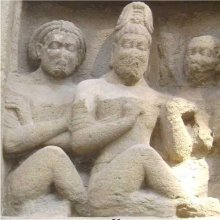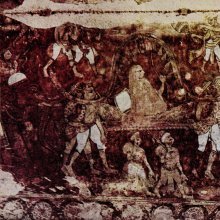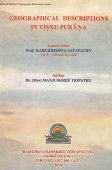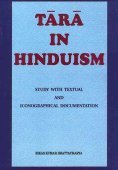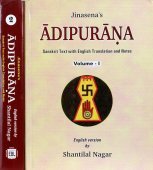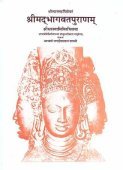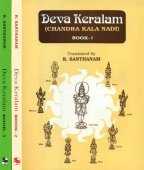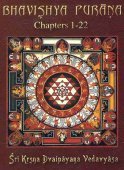Vyasa, Vyāsa, Vyasha: 42 definitions
Introduction:
Vyasa means something in Buddhism, Pali, Hinduism, Sanskrit, Jainism, Prakrit, the history of ancient India, Marathi, Hindi. If you want to know the exact meaning, history, etymology or English translation of this term then check out the descriptions on this page. Add your comment or reference to a book if you want to contribute to this summary article.
Images (photo gallery)
In Hinduism
Purana and Itihasa (epic history)
Source: Wisdom Library: ItihasaVyasa is the original composer of the Bharata (the predecessor of the Mahabharata). Vyasa had a disciple, called Vaisampayana, who was a very important and intelligent disciple of Vyasa and the first to recite the Bharata, to King Janamejaya.
Source: Wisdom Library: Bhagavata PuranaVyāsa (व्यास) or Vyāsadeva (व्यासदेव):—The popular name for Bādarāyaṇa, who was begotten by Parāśara Muni through the womb of Satyavatī. He had a brother named Vicitravīrya. He also begot two sons two by the womb of Ambikā and Ambālikā (the two wifes of Vicitravīrya, his brother), and one son by a maidservant of Vicitravīrya. They were named Dhṛtarāṣṭra, Pāṇḍu and Vidura. He also had a son named Śukadeva Gosvāmī. (see Bhāgavata Purāṇa 9.22.21-25)
Source: archive.org: Puranic EncyclopediaVyāsa (व्यास).—The sage Vyāsa who is the author of the Mahā-Bhārata. Genealogy. Descended from Viṣṇu in the following order: Brahmā-Vasiṣṭha-Śakti-Parāśara-Vyāsa. (See full article at Story of Vyāsa from the Puranic encyclopaedia by Vettam Mani)
Source: archive.org: Shiva Purana - English TranslationVyāsa (व्यास) is the name of a Sage (Muni) who once attended a great sacrifice by Dakṣa, according to the Śivapurāṇa 2.2.27. Accordingly as Brahmā narrated to Nārada:—“[...] once a great sacrifice was started by Dakṣa, O sage. To partake in that sacrifice, the celestial and terrestrial sages and devas were invited by Śiva and they reached the place being deluded by Śiva’s Māyā. [Vyāsa, ...] and many others along with their sons and wives arrived at the sacrifice of Dakṣa—my son”.
Note: Vyāsa is the title is applied to Vedavyāsa, the arranger of the Vedas, the compiler of the Mahābhārata, the founder of the Vedānta philosophy and the arranger of the Purāṇas. Dowson doubts the identity of these different arrangers. Vyāsa is also called Kṛṣṇa-Dvaipayana. From his complexion he received the name Krṣṇa and from his birth place he was called Dvaipāyaṇa.
Source: Cologne Digital Sanskrit Dictionaries: The Purana Index1a) Vyāsa (व्यास).—An aṃśāvatāra of Viṣṇu; also known as Dvaipāyana and Kṛṣṇa; son of Parāśara and Vāsavī (Satyavatī) in Dvāpara yuga. Father of Śuka; appointed by his mother, he begot three sons on his brother's wife being childlessDhṛtarāṣṭra, Pāṇḍu and Vidura.1 Rearranged the Vedas into four parts, and taught each of them to four respective pupils—Paila, Vaiśampāyana, Jaimini and Sumantu. Rearranged Itihāsa-Purāṇas also; composed the bhārata for Strīśūdra-dvijabandhus; composed also the bhāgavata and taught it to his son Śuka, having heard it from Nārada.2 When he felt a mental dissatisfaction, Nārada met him and was praised. Asked as to the reason for his uneasiness, Nārada emphasised devotion to Hari as the means of release and proceeded to narrate the story of his previous birth. When the sage left Vyāsa retired to his hermitage Śamyāprāsa on the Sarasvatī and meditated on the Lord who appeared before him with māyā depending on him. Learnt devotion as the means of ending saṃsāra.3 One of Yudhiṣṭhira's party on a visit to Bhīṣma; was a Purohita at Kṛṣṇa's sacrifice at Kurukṣetra; told the history of Citraketu to Śuka who bowed to him.4 Heard śrutigītā from Nārāyaṇa. Faith in Kriyāyoga; a siddha.5 Taught Lomaharṣaṇa about the future of the world and its history.6 An incarnation of the Lord in every dvāpara;7 took a vow of silence and fasting for 12 years after which he wandered for food but could not get any in Benares; when he was about to curse the city, Śiva and Umā took the guise of householders and offered him rich food. So he blessed it.8 A tīrtha in his honour.9
- 1) Bhāgavata-purāṇa I. 2. 4; 4. 14-15; IX. 22. 22-25; XII. 6. 36; III. 5. 19-20; Matsya-purāṇa 15. 8; 180. 64; Brahmāṇḍa-purāṇa III. 10. 79-80; 13. 77.
- 2) Bhāgavata-purāṇa XII. 6. 49-53; I. 4. 16-25; 7. 1-8; II. 9. 44; III. 5. 10 and 12; XII. 4. 42; 13. 19; Brahmāṇḍa-purāṇa I. 1. 25; II. 31. 28; 33. 32-3; 34. 11-12; III. 17. 295.
- 3) Bhāgavata-purāṇa I. 4. 30-33; chh. 5 and 6 (whole); 7. 1-4;
- 4) Ib. I. 8. 46; 9. 2; X. 90. 46[2]; VI. 14. 9; VII. 1. 5.
- 5) Ib. X. 87. 47-8; XI. 27. 2; VI. 15. 12.
- 6) Matsya-purāṇa 50. 72.
- 7) Ib. 53. 9.
- 8) Ib. 185. 17-38.
- 9) Ib. 191. 41; 203. 14.
1b) A sage of the eighth manvantara.*
- * Bhāgavata-purāṇa VIII. 13. 15; Viṣṇu-purāṇa III. 2. 17.
Vyāsa (व्यास) refers to the “arranger” who divides the original Purāṇa every dvāparayuga.—The divine origin of the Purāṇas is made explicit in the Purāṇas themselves. According to the Purāṇas originally the Purāṇa was one and was first thought of by Brahmā, emanating from his fifth mouth to the extent of a hundred crores of ślokas. This original Purāṇa continues to exist in the world of the Gods, but is abridged by Vyāsa, “The Arranger”, in each dvāparayuga into an essence of four lakhs of ślokas and this essence is then divided by Vyāsa into the eighteen Purāṇas existing in this mortal world. The divinity of the Puranic origin is asserted by affirming Vyāsa to be an incarnation of Viṣṇu.
The Puranic tradition of the human origin of Purāṇas is based on seeing Vyāsa not as the editor of divine Purāṇa but as the arranger of already existing material. As it is said: “He (Vyāsa) who understands the true meaning of Puranic lore, composed the Purāṇasamhita out of tales, episodes, ballads and description of the ages” (cf. Brahmāṇḍapurāṇa II.32.21, Varāhapurāṇa 1.60.21 and Viṣṇupurāṇa 6.15).

The Purana (पुराण, purāṇas) refers to Sanskrit literature preserving ancient India’s vast cultural history, including historical legends, religious ceremonies, various arts and sciences. The eighteen mahapuranas total over 400,000 shlokas (metrical couplets) and date to at least several centuries BCE.
Kavya (poetry)
Source: Shodhganga: A critical appreciation of soddhalas udayasundarikathaVyāsa (व्यास).—Name of a poet mentioned by Soḍḍhala in the kavipraśasti (eulogy of poets) of his Udayasundarīkathā;—Tradition names Vyāsa as an entirely mythical seer of ancient times, who was supposed to be at the same time the compiler of the Mahābhārata and the Purāṇas. He was the son of Paraśara and Satyavatī. He was born at a Dvipa and was dark in colour; as such he is designated as Kṛṣṇa Dvaipāyana.
He had five pupils, namely
- Sumantu,
- Jaimini,
- Paila,
- Vaiśampāyana,
- and his own son Śuka.
He taught them Jaya and they accordingly expanded it.

Kavya (काव्य, kavya) refers to Sanskrit poetry, a popular ancient Indian tradition of literature. There have been many Sanskrit poets over the ages, hailing from ancient India and beyond. This topic includes mahakavya, or ‘epic poetry’ and natya, or ‘dramatic poetry’.
Vyakarana (Sanskrit grammar)
Source: Wikisource: A dictionary of Sanskrit grammar1) Vyāsa (व्यास).—Showing separately; separate expression as contrasted with समास (samāsa);
2) Vyāsa.—Fault of pronunciation of the type of unnecessarily extending the place of origin as also the instrument of the production of sound; cf. स्थानकरणयोर्विस्तारे व्यासो नाम दोषो जायते (sthānakaraṇayorvistāre vyāso nāma doṣo jāyate) Uvvata on R. Pr. XIV. 2.

Vyakarana (व्याकरण, vyākaraṇa) refers to Sanskrit grammar and represents one of the six additional sciences (vedanga) to be studied along with the Vedas. Vyakarana concerns itself with the rules of Sanskrit grammar and linguistic analysis in order to establish the correct context of words and sentences.
Chandas (prosody, study of Sanskrit metres)
Source: Shodhganga: a concise history of Sanskrit Chanda literatureVyāsa (व्यास) is the name of an author of works dealing with prosodoy (chandas or chandaśśāstra) quoted by Kṣemendra (11th century) in his Suvṛttatilaka. The Suvṛttatilaka is a monumental work of Sanskrit prosody in which the author discusses 27 popular metres which were used frequently by the poets (e.g., Vyāsa).

Chandas (छन्दस्) refers to Sanskrit prosody and represents one of the six Vedangas (auxiliary disciplines belonging to the study of the Vedas). The science of prosody (chandas-shastra) focusses on the study of the poetic meters such as the commonly known twenty-six metres mentioned by Pingalas.
Jyotisha (astronomy and astrology)
Source: Wikibooks (hi): Sanskrit Technical TermsVyāsa (व्यास).—1. Diameter. 2. (sometimes) radius. 3. Breadth. Note: Vyāsa is a Sanskrit technical term used in ancient Indian sciences such as Astronomy, Mathematics and Geometry.

Jyotisha (ज्योतिष, jyotiṣa or jyotish) refers to ‘astronomy’ or “Vedic astrology” and represents the fifth of the six Vedangas (additional sciences to be studied along with the Vedas). Jyotisha concerns itself with the study and prediction of the movements of celestial bodies, in order to calculate the auspicious time for rituals and ceremonies.
Vaishnavism (Vaishava dharma)
Source: Pure Bhakti: Bhagavad-gita (4th edition)Vyāsa (व्यास) refers to “vedavyāsa, the literary incarnation of the Lord and the compiler of Vedas, Purāṇas, Upaniṣads, Brahma-sūtra and Śrīmad-Bhāgavatam”. (cf. Glossary page from Śrīmad-Bhagavad-Gītā).
Source: Pure Bhakti: Brhad BhagavatamrtamVyāsa (व्यास) refers to:—A great sage and empowered incarnation of the Lord, son of Parāśara Muni and Satyavatī. He is also known as Bādarāyaṇa, Dvaipāyana, and Veda-Vyāsa. Although the Vedas are eternal, because it was he who dictated them at the beginning of this age of Kali, he is known as the author of the Vedas and all Śruti and Smṛti literature. (cf. Glossary page from Śrī Bṛhad-bhāgavatāmṛta).

Vaishnava (वैष्णव, vaiṣṇava) or vaishnavism (vaiṣṇavism) represents a tradition of Hinduism worshipping Vishnu as the supreme Lord. Similar to the Shaktism and Shaivism traditions, Vaishnavism also developed as an individual movement, famous for its exposition of the dashavatara (‘ten avatars of Vishnu’).
Vedanta (school of philosophy)
Source: Shodhganga: Siva Gita A Critical StudyVyāsa (व्यास) or Vyāsagītā refers to one of the sixty-four Gītās commonly referred to in Hindu scriptures.—Gītā is the name given to certain sacred writings in verse (often in the form of a dialogue) which are devoted to the exposition of particular religious and theosophical doctrines. Most of these Gītās [i.e., Vyāsa-gītā] originate from the Mahābhārata or the various Purāṇas.

Vedanta (वेदान्त, vedānta) refers to a school of orthodox Hindu philosophy (astika), drawing its subject-matter from the Upanishads. There are a number of sub-schools of Vedanta, however all of them expound on the basic teaching of the ultimate reality (brahman) and liberation (moksha) of the individual soul (atman).
Ayurveda (science of life)
Source: gurumukhi.ru: Ayurveda glossary of termsVyāsa (व्यास):—Throwing of extremities outward.

Āyurveda (आयुर्वेद, ayurveda) is a branch of Indian science dealing with medicine, herbalism, taxology, anatomy, surgery, alchemy and related topics. Traditional practice of Āyurveda in ancient India dates back to at least the first millenium BC. Literature is commonly written in Sanskrit using various poetic metres.
Shaktism (Shakta philosophy)
Source: Google Books: ManthanabhairavatantramVyāsa (व्यास) is the name of a Ṛṣi, according to the second recension of the Yogakhaṇḍa of the Manthānabhairavatantra, a vast sprawling work that belongs to a corpus of Tantric texts concerned with the worship of the goddess Kubjikā.—Accordingly, “[...] The lord renounced (everything, including the observance of his vow) at the confluence of the Ganges and Yamuna by himself and, having brought about his own splitting apart of the Liṅga, returned to Vārāṇasī. He then assumed the form of a Ṛṣi, that is, a great sage by the name of Vyāsa. (And so) that same Śaṃkara yoked to Māyā (became) Vyāsa-Śaṃkara and, in order to earn (the boon of the) Command, he returned to the goddess’s hermitage. [...]”.

Shakta (शाक्त, śākta) or Shaktism (śāktism) represents a tradition of Hinduism where the Goddess (Devi) is revered and worshipped. Shakta literature includes a range of scriptures, including various Agamas and Tantras, although its roots may be traced back to the Vedas.
Pancaratra (worship of Nārāyaṇa)
Source: Wisdom Library: Pancaratra (Samhita list)1) Vyāsa (व्यास) is the name of an ancient Pāñcarātra Saṃhitā mentioned in the Kapiñjalasaṃhitā: a Pāñcarātra work consisting of 1550 verses dealing with a variety of topics such as worship in a temple, choosing an Ācārya, architecture, town-planning and iconography.—For the list of works, see chapter 1, verses 14b-27. The list [including Vyāsa-saṃhitā] was said to have comprised “108” titles, these, different saṃhitās named after different manifestations of the Lord or different teachers. They are all said to be authoritative as the ultimate promulgator of all these is the same Nārāyaṇa.
2) Vyāsa (व्यास) is the name of an ancient Pāñcarātra Saṃhitā mentioned in the Padmasaṃhitā: the most widely followed of Saṃhitā covering the entire range of concerns of Pāñcarātra doctrine and practice (i.e., the four-fold formulation of subject matter—jñāna, yoga, kriyā and caryā) consisting of roughly 9000 verses.—[Cf. Jñānapāda chapter 1, verses 99-114]—First is explained the folly of following more than one Saṃhitā for a single series of rituals. Then the names of the 108 Tantras of the Pāñcarātra corpus are named [e.g., Vyāsa]. Even those who repeat these 108 titles will gain salvation.
3) Vyāsa (व्यास) or Vyāsasaṃhitā is also mentioned in the Puruṣottamasaṃhitā: a Pāñcarātra text consisting of more than 1800 verses devoted to temple-building and the practical concerns of the Pāñcarātra priestly community.
Source: archive.org: Catalogue of Pancaratra Agama TextsVyāsa (व्यास) is mentioned as a teacher who counter-argue the Buddhists and Jains, according to chapter 15 of the (fourth part of the) Śāṇḍilyasaṃhitā: a Pāñcarātra text comprising 3600 Sanskrit verses dealing with devotion towards Kṛṣṇa who is identified with the Supreme, as well as ethical behavior and pious practices to be observed by devotees (bhaktas).—Description of the chapter [bhaviṣyadācārya-nirūpaṇa]: A more detailed prediction is made concerning the (tempting) avatāras God will take as Buddha (1-8). [...] Those who appear to counter-argue the Buddhists and Jains number among themselves such names as: [e.g., Vyāsa] [...]. And each of these teachers will have a following: among them Ruru who himself had hundreds of followers. [...]

Pancaratra (पाञ्चरात्र, pāñcarātra) represents a tradition of Hinduism where Narayana is revered and worshipped. Closeley related to Vaishnavism, the Pancaratra literature includes various Agamas and tantras incorporating many Vaishnava philosophies.
Vastushastra (architecture)
Source: archive.org: Catalogue of Pancaratra Agama Texts (vastu)Vyāsa (व्यास) refers to one of the fifty-two varieties of Temples (prāsāda), as discussed in chapter 8 (Kriyāpāda) of the Padmasaṃhitā: the most widely followed of Saṃhitā covering the entire range of concerns of Pāñcarātra doctrine and practice (i.e., the four-fold formulation of subject matter—jñāna, yoga, kriyā and caryā) consisting of roughly 9000 verses.—Description of the chapter [prāsāda-bheda]:—This is ostensibly a highly technical chapter on varieties of vimāna-types. There are 52 varieties of vimānas mentioned [e.g., Vyāsa] based on differences of tāla-measurements and adhiṣṭhāna-basements; but the treatment upon examination gives only the most superficial of distinctions between one type and another.

Vastushastra (वास्तुशास्त्र, vāstuśāstra) refers to the ancient Indian science (shastra) of architecture (vastu), dealing with topics such architecture, sculpture, town-building, fort building and various other constructions. Vastu also deals with the philosophy of the architectural relation with the cosmic universe.
General definition (in Hinduism)
Source: WikiPedia: HinduismHindus traditionally hold that Vyasa categorised the primordial single Veda into four. Hence he was called Veda Vyasa, or "Splitter of the Vedas," the splitting being a feat that allowed people to understand the divine knowledge of the Veda. The word vyasa means split, differentiate, or describe.
The Vishnu Purana has a theory about Vyasa. The Hindu view of the universe is that of a cyclic phenomenon that comes into existence and dissolves repeatedly. Each cycle is presided over by a number of Manus, one for each Manvantara, that has four ages, Yugas of declining virtues. The Dvapara Yuga is the third Yuga. The Vishnu Purana (Book 3, Ch 3) says:
Source: WikiPedia: HinduismIn every third world age (Dvapara), Vishnu, in the person of Vyasa, in order to promote the good of mankind, divides the Veda, which is properly but one, into many portions. Observing the limited perseverance, energy, and application of mortals, he makes the Veda fourfold, to adapt it to their capacities; and the bodily form which he assumes, in order to effect that classification, is known by the name of Veda-vyasa. Of the different Vyasas in the present Manvantara and the branches which they have taught, you shall have an account.
Twenty-eight times have the Vedas been arranged by the great Rishis in the Vaivasvata Manvantara... and consequently eight and twenty Vyasas have passed away; by whom, in the respective periods, the Veda has been divided into four. The first... distribution was made by Svayambhu (Brahma) himself; in the second, the arranger of the Veda (Vyasa) was Prajapati... (and so on up to twenty-eight).
Vyasa is a central and revered figure in most Hindu traditions. He is the author as well as a character in the Mahabharata and considered to be the scribe of both the Vedas, and the supplementary texts such as the Puranas. Vyasa is sometimes conflated by some Vaishnavas with Badarayana, the author of the Vedanta Sutras. Vyāsa is also considered to be one of the seven Chiranjivins (long lived, or immortals), who are still in existence according to general Hindu belief.
Vyasa appears for the first time as the author of, and an important character in the Mahābhārata. He was the son of Satyavati, daughter of a ferryman or fisherman, and the wandering sage Parashara. He was born on an island in the river Yamuna. The place is named after him as Vedvyas, possibly the modern-day town of Kalpi in the Jalaun district of Uttar Pradesh. He was dark-complexioned and hence may be called by the name Krishna (black), and also the name Dwaipayana, meaning 'island-born'.
Vyasa was grandfather to the Kauravas and Pandavas. Their fathers, Dhritarashtra and Pandu, adopted as the sons of Vichitravirya by the royal family, were fathered by him. He had a third son, Vidura, by a serving maid.
Vyasa (Devanagari: व्यास, vyāsa)
He is also sometimes called Veda Vyasa (वेद व्यास, veda vyāsa), (the one who classified the Vedas in to four parts) or Krishna Dvaipayana (referring to his complexion and birthplace)
Also see: Badarayana
Source: Apam Napat: Indian MythologyVyasa is the son of Satyavati and the sage Parasara. Satyavati was the adopted daughter of a fisherman, and plied a boat across the river Yamuna. One day she was taking the sage Parasara across. The sage was smitten with sudden desire for this woman, and she consented. The sage created a mist around an island in the middle of the river and there they consummated their passion. Such was the power of the rishi, that a son was born immediately to Satyavati. Even more remarkably, the son (Vyasa) immediately grew into a man, immensly learned in the scriptures! The sage then granted a boon to Satyavati, first that of converting her fishy odor to a divine fraganace and then by restoring her chastity.
Vyasa is also the biological father of Pandu, Dhritharashtra and Vidura. He is most famous as the composer of Mahabharata, which he dictated to Ganapati.
In Buddhism
Tibetan Buddhism (Vajrayana or tantric Buddhism)
Source: Wisdom Library: Tibetan BuddhismVyāsa (व्यास) refers to one of the various Ṛṣis (sages) and Mahārṣis (great sages) mentioned as attending the teachings in the 6th century Mañjuśrīmūlakalpa: one of the largest Kriyā Tantras devoted to Mañjuśrī (the Bodhisattva of wisdom) representing an encyclopedia of knowledge primarily concerned with ritualistic elements in Buddhism. The teachings in this text originate from Mañjuśrī and were taught to and by Buddha Śākyamuni in the presence of a large audience (including Vyāsa).

Tibetan Buddhism includes schools such as Nyingma, Kadampa, Kagyu and Gelug. Their primary canon of literature is divided in two broad categories: The Kangyur, which consists of Buddha’s words, and the Tengyur, which includes commentaries from various sources. Esotericism and tantra techniques (vajrayāna) are collected indepently.
In Jainism
General definition (in Jainism)
Source: archive.org: TrisastisalakapurusacaritraVyāsa (व्यास) refers to the traditional compiler of the Mahābhārata, as mentioned in chapter 1.5 [ādīśvara-caritra] of Hemacandra’s 11th century Triṣaṣṭiśalākāpuruṣacaritra: an ancient Sanskrit epic poem narrating the history and legends of sixty-three illustrious persons in Jainism. Accordingly:—“[...] Bards, excited by battle, joyful as if on a festival-day, wandered unconfused to every elephant, every chariot, and every horse, recalling the adventures of men of former times, as if they had been seen at that time; praising the fruit of steadfastness in battle, like Vyāsa; celebrating again and again zealously the adversaries present, to inflame the warriors, like the sage Nārada”.

Jainism is an Indian religion of Dharma whose doctrine revolves around harmlessness (ahimsa) towards every living being. The two major branches (Digambara and Svetambara) of Jainism stimulate self-control (or, shramana, ‘self-reliance’) and spiritual development through a path of peace for the soul to progess to the ultimate goal.
India history and geography
Source: Wisdom Library: Teachers, Saints and SagesVyāsa (व्यास) or Vyāsamuni is another name for Vyasamunivar—one of the Siddhars (Siddhas) and Rishis mentioned by Rangarasa Desiga Swamigal in his Siddhargal Potri Thoguppu. Each name in the list starts with prefix ‘Om’ followed by the Siddhar’s names and ends with refrain ‘Thiruvadigal Potri’. For example for Vyāsa-muni: ஓம் வியாசமுனிவர் திருவடிகள் போற்றி [ōm viyācamuṉivar tiruvaṭikaḷ pōṟṟi].—These Siddhas experienced union with the ultimate reality and witnessed a spiritual transformation of their intellectual, mental, vital and ultimately, physical bodies.
Source: archive.org: Personal and geographical names in the Gupta inscriptionsVyāsa (व्यास) is an example of a name based on an Epic or Purana mentioned in the Gupta inscriptions. The Gupta empire (r. 3rd-century CE), founded by Śrī Gupta, covered much of ancient India and embraced the Dharmic religions such as Hinduism, Buddhism and Jainism. Derivation of personal names (e.g., Vyāsa) during the rule of the Guptas followed patterns such as tribes, places, rivers and mountains.
Source: Cologne Digital Sanskrit Dictionaries: Indian Epigraphical GlossaryVyāsa.—(EI 11; PJS), a reciter or exponent; a Brāhmaṇa who recites or expounds the epics and Purāṇas in public. Cf. Paurāṇika. Note: vyāsa is defined in the “Indian epigraphical glossary” as it can be found on ancient inscriptions commonly written in Sanskrit, Prakrit or Dravidian languages.
Source: Singhi Jain Series: Ratnaprabha-suri’s Kuvalayamala-katha (history)Vyāsa (व्यास) is the author of the Bhārata, as mentioned by Uddyotanasūri in his 8th-century Kuvalayamālā (a Prakrit Campū, similar to Kāvya poetry) narrating the love-story between Prince Candrāpīḍa and the Apsaras Kādambarī.—The Kuvalayamala (779 A.D.) is full of cultural material which gains in value because of the firm date of its composition. [...] On pages 3.18-4.12, Uddyotanasūri gives the names of a number of Kathās and their authors, in Sanskrit, Prakrit and Apabhramsha, [i.e., Vyāsa and Vālmīki to whom we owe Bhārata and Rāmāyaṇa], [...]—That was the usual practice of all writers like Subandhu, Bāṇa, Daṇḍin, Haribhadra, Svayaṃbhū etc. We are able to know the names of about fifty works including romances. Dr. A. N. Upadhye has dealt with these in his paper entitled “Works and Authors referred to in the Kuvalayamālā of Uddyotanasūri” submitted to the A.I.O.C. Session at Gauhati.

The history of India traces the identification of countries, villages, towns and other regions of India, as well as mythology, zoology, royal dynasties, rulers, tribes, local festivities and traditions and regional languages. Ancient India enjoyed religious freedom and encourages the path of Dharma, a concept common to Buddhism, Hinduism, and Jainism.
Languages of India and abroad
Pali-English dictionary
Source: Sutta: The Pali Text Society's Pali-English DictionaryVyāsa, (fr. vi+ās to sit) separation, division; always contrasted with samāsa, e.g. Vism. 82 (vyāsato separately, distributively; opp. samāsato); KhA 187. (Page 654)

Pali is the language of the Tipiṭaka, which is the sacred canon of Theravāda Buddhism and contains much of the Buddha’s speech. Closeley related to Sanskrit, both languages are used interchangeably between religions.
Marathi-English dictionary
Source: DDSA: The Molesworth Marathi and English Dictionaryvyāsa (व्यास).—. m (S) The proper name of a saint and author, the supposed compiler of the Vedas and Puraṇs, also the founder of the Vedanta philosophy. Hence, appellatively, an expounder of the Puraṇs. 2 Diameter or width.
Source: DDSA: The Aryabhusan school dictionary, Marathi-Englishvyāsa (व्यास).—m Diameter. An expounder of the purāṇa.
Marathi is an Indo-European language having over 70 million native speakers people in (predominantly) Maharashtra India. Marathi, like many other Indo-Aryan languages, evolved from early forms of Prakrit, which itself is a subset of Sanskrit, one of the most ancient languages of the world.
Sanskrit dictionary
Source: DDSA: The practical Sanskrit-English dictionaryVyāsa (व्यास).—1 Distribution, separation into parts.
2) Dissolution or analysis of a compound.
3) Severalty, distinction.
4) Diffusion, extension; तस्यैव व्यासमिच्छामि ज्ञातुं ते भगवन् यथा (tasyaiva vyāsamicchāmi jñātuṃ te bhagavan yathā) Bhāgavata 6.4.2.
5) Width, breadth.
6) The diameter of a circle.
7) A fault in pronunciation.
8) Arrangement, compliation.
9) An arranger, a compiler; द्वैपायनोऽस्मि व्यासानां कवीनां काव्य आत्मवान् (dvaipāyano'smi vyāsānāṃ kavīnāṃ kāvya ātmavān) Bhāg. 11.16.28.
1) Name of a celebrated sage. [He was the son of the sage Parāśara by Satyavatī (born before her marriage with Śantanu q. v.); but he retired to the wilderness as soon as he was born, and there led the life of a hermit, practising the most rigid austerities until he was called by his mother Satyavatī to beget sons on the widows of her son Vichitravīrya. He was thus the father of Pāṇḍu and Dhṛtarāṣṭra and also of Vidura; q. q. v. v. He was at first called 'Kṛṣṇadvaipāyana' from his dark complexion and from his having been brought forth by Satyavatī on a Dvīpa or island; but he afterwards came to be called Vyāsa or 'the arranger,' as he was supposed to have arranged the Vedas in their present form; विव्यास वेदान् यस्मात् स तस्माद् व्यास इति स्मृतः (vivyāsa vedān yasmāt sa tasmād vyāsa iti smṛtaḥ) cf. also जातः स यमुनद्वीपे द्वैपायन इति स्मृतः । व्यस्य वेदान् समस्ताश्च व्यासतामगमद्विभुः (jātaḥ sa yamunadvīpe dvaipāyana iti smṛtaḥ | vyasya vedān samastāśca vyāsatāmagamadvibhuḥ) || Bm.1.214. He is believed to be the author of the great epic, the Mahābhārata, which he is said to have composed with Gaṇapati for his scribe. The eighteen Purāṇas, as also the Brahma-sūtras and several other works are also ascribed to him. He is one of the seven chirajeevins or deathless persons; cf. चिरजीविन् (cirajīvin).]
11) A Brāhmaṇa who recites or expounds the Purāṇas in public.
Derivable forms: vyāsaḥ (व्यासः).
Source: Cologne Digital Sanskrit Dictionaries: Shabda-Sagara Sanskrit-English DictionaryVyāsa (व्यास).—m.
(-saḥ) 1. A celebrated saint and author, the supposed original compiler of the Vedas and Puranas; also the founder of the Vedanta philosophy. 2. Diffusion, extension. 3. Detail, distinction, severalty. 4. A measure. 5. The diameter of a circle. 6. A fault in pronunciation. 7. Arrangement, compilation. 8. The analysis of a compound word. 9. A public reader of the Puranas. E. vi and āṅ before as to pervade, aff. ghañ .
Source: Cologne Digital Sanskrit Dictionaries: Benfey Sanskrit-English DictionaryVyāsa (व्यास).—i. e. vi- 2. as + a, m. 1. Extension, diffusion. 2. Distinction, detail. 3. A sage, the supposed compiler of the Vedas and Purāṇas, [Lassen, Anthologia Sanskritica.] 49, 2;
Vyāsa (व्यास).—[masculine] separation, division; extension, diffusion, prolixity; [Name] of a celebrated Ṛṣi and author.
Source: Cologne Digital Sanskrit Dictionaries: Aufrecht Catalogus Catalogorum1) Vyāsa (व्यास) as mentioned in Aufrecht’s Catalogus Catalogorum:—a title of Sudarśanācārya (Śrutaprakāśikā). Mysore. 6.
2) Vyāsa (व्यास):—one of the six gurus of Ṣaḍguruśiṣya. W. p. 12.
3) Vyāsa (व्यास):—father of Rāmadeva, father of Mahābala, father of Nārāyaṇa (Gobhilagṛhyasūtrabhāṣya). Oxf. 365^a.
4) Vyāsa (व्यास):—[+vyāsa] See Vedavyāsa: Itihāsa. B. 2, 128. A strange title. Kṛchracāndrāyaṇalakṣaṇa. Gaṇeśapañcaratna. Golādhyāya. See Vyāsasiddhānta. Tattvabodha and—[commentary]. Tīrthaparibhāṣā. Dattakadarpaṇa. Pratimālakṣaṇa. Bālakṛṣṇāṣṭaka. Bṛhatsaṃhitā. Brahmasūtra, a substitute for the name Bādarāyaṇa. Mahābhārata and all Purāṇas. Yogasūtrabhāṣya. Vakratuṇḍastotra. Vakratuṇḍāṣṭaka. Viśvanāthāṣṭaka. Śivatattvaviveka.
5) Vyāsa (व्यास):—son of Janārdana: Tantrasāraṭīkā.
6) Vyāsa (व्यास):—pupil of Nṛsiṃha: Saṃdhyāvandanamantrabhāṣya.
Source: Cologne Digital Sanskrit Dictionaries: Monier-Williams Sanskrit-English Dictionary1) Vyāśā (व्याशा):—[=vy-āśā] [from vy] a f. an intermediate quarter (of the compass), [Rāmatāpanīya-upaniṣad]
2) Vyāsa (व्यास):—[=vy-āsa] [from vy-as] a m. severing, separation, division, [Sarvadarśana-saṃgraha]
3) [v.s. ...] a kind of drawl (as a fault in pronunciation), [Atharvaveda-prātiśākhya]
4) [v.s. ...] extension, diffusion, prolixity, detailed account ([instrumental case]; [ablative] and -tas ind. in detail, at length, fully), [Mahābhārata; Suśruta; Bhāgavata-purāṇa]
5) [v.s. ...] width, breadth, the diameter of a circle, [Śulba-sūtra; Varāha-mihira’s Bṛhat-saṃhitā]
6) [v.s. ...] ‘distributing, disjoining’, Name of the Pada-pāṭha or ‘disjoined text’ [Atharvaveda-prātiśākhya]
7) [v.s. ...] ‘arranger, compiler’, Name of a celebrated mythical sage and author (often called Veda-vyāsa and regarded as the original compiler and arranger of the Vedas, Vedānta-sūtras etc.; he was the son of the sage Parāśara and Satyavatī, and half-brother of Vicitra-vīrya and Bhīṣma; he was also called Vādarāyaṇa or Bādarāyaṇa, and Kṛṣṇa from his dark complexion, and Dvaipāyana because he was brought forth by Satyavatī on a Dvīpa or island in the Jumnā; when grown up he retired to the wilderness to lead the life of a hermit, but at his mother’s request returned to become the husband of Vicitra-vīrya’s two childless widows, by whom he was the father of the blind Dhṛta-rāṣṭra and of Pāṇḍu; he was also the father of Vidura q.v. by a slave girl, and of Śuka, the supposed narrator of the Bhāgavata-Purāṇa, he was also the supposed compiler of the Mahā-bhārata, the Purāṇas, and other portions of Hindū sacred literature; but the name Vyāsa seems to have been given to any great typical compiler or author), [Mahābhārata; Harivaṃśa; Purāṇa] cf. [Indian Wisdom, by Sir M. Monier-Williams 371 n. 2; 373 etc.]
8) [v.s. ...] a Brāhman who recites or expounds the Purāṇas etc. in public (= pāṭhaka-brāhmaṇa), [Monier-Williams’ Sanskrit-English Dictionary]
9) [v.s. ...] n. a bow weighing 100 Palas, [cf. Lexicographers, esp. such as amarasiṃha, halāyudha, hemacandra, etc.]
10) Vyāśā (व्याशा):—[=vy-āśā] b See p. 1028, col. 3.
11) Vyāsa (व्यास):—[=vy-āsa] b etc. See p. 1035, col. 2.
Source: Cologne Digital Sanskrit Dictionaries: Yates Sanskrit-English DictionaryVyāsa (व्यास):—[vyā+sa] (saḥ) 1. m. A celebrated saint and author; compiler of the Vedas, &c.; diffusion; detail; a measure. n. A diameter.
Source: DDSA: Paia-sadda-mahannavo; a comprehensive Prakrit Hindi dictionary (S)Vyāsa (व्यास) in the Sanskrit language is related to the Prakrit word: Vāsa.
[Sanskrit to German]
Sanskrit, also spelled संस्कृतम् (saṃskṛtam), is an ancient language of India commonly seen as the grandmother of the Indo-European language family (even English!). Closely allied with Prakrit and Pali, Sanskrit is more exhaustive in both grammar and terms and has the most extensive collection of literature in the world, greatly surpassing its sister-languages Greek and Latin.
Hindi dictionary
Source: DDSA: A practical Hindi-English dictionaryVyāsa (व्यास) [Also spelled vyas]:—(nm) diameter, calibre; diffusion; a celebrated ancient Indian sage and savant; ~[pīṭha] dais; -[śailī] diffused style.
...
Kannada-English dictionary
Source: Alar: Kannada-English corpusVyāsa (ವ್ಯಾಸ):—
1) [noun] a severing, separating or being severed, separated; separation.
2) [noun] the act of spreading, diffusing or pervading; diffusion; pervasion.
3) [noun] the space, amount or degree to which a thing extends; extent; width; breadth.
4) [noun] the act or process of explaining.
5) [noun] a meaning or interpretation.
6) [noun] a straight line passing through the centre of a circle, from one end to the other end of the circumference; a diametre.
7) [noun] a man who compiles (something) from various sources.
8) [noun] Kṛṣṇa Dvaipāyana, the sage who collected, classified and edited the vedas and wrote Mahābhārata.
9) [noun] a throwing (of something) in different directions10) [noun] ವ್ಯಾಸನ ತೋಳು [vyasana tolu] vyāsana tōḷu = ವ್ಯಾಸಧ್ವಜ [vyasadhvaja].
Kannada is a Dravidian language (as opposed to the Indo-European language family) mainly spoken in the southwestern region of India.
Nepali dictionary
Source: unoes: Nepali-English DictionaryVyāsa (व्यास):—n. diameter; divider;
Nepali is the primary language of the Nepalese people counting almost 20 million native speakers. The country of Nepal is situated in the Himalaya mountain range to the north of India.
See also (Relevant definitions)
Partial matches: Asha, Vy, Aashaa, Aca.
Starts with (+21): Vyasa acarya, Vyasa bhatta, Vyasa mokshaditya, Vyasa Shiksha, Vyasa shri ramadeva, Vyasa vitthala, Vyasacaritra, Vyasadala, Vyasadasa, Vyasadatti, Vyasadeva, Vyasadhvaja, Vyasadipika, Vyasagadya, Vyasaganapati, Vyasagiri, Vyasagita, Vyasahasta, Vyasakeshava, Vyasakuta.
Query error!
Full-text (+1283): Vedavyasa, Vyasapuja, Ardhavyasa, Vyasasthali, Vyasavana, Vyasaparipriccha, Vyasakeshava, Vyasashataka, Vyasagita, Vyaseshvara, Vyasardha, Vyasadasa, Vyasatirtha, Dvaipayana, Vyasavarya, Yadavavyasa, Brihadvyasa, Vyasasiddhanta, Vyasapitha, Vyasasmriti.
Relevant text
Search found 231 books and stories containing Vyasa, Vy-āśā, Vy-asa, Vy-āsa, Vy-asha, Vyāsa, Vyāśā, Vyasas, Vyasha; (plurals include: Vyasas, āśās, asas, āsas, ashas, Vyāsas, Vyāśās, Vyasases, Vyashas). You can also click to the full overview containing English textual excerpts. Below are direct links for the most relevant articles:
The Glorification of Vyasa (Part 2) < [Purana, Volume 10, Part 2 (1968)]
The Glorification of Vyasa < [Purana, Volume 9, Part 2 (1967)]
A note on the Vyasa-Gayatri < [Purana, Volume 8, Part 2 (1966)]
Garga Samhita (English) (by Danavir Goswami)
Verse 6.15.36 < [Chapter 15 - The Glories of Nṛga-kūpa and Gopī-bhūmi]
Verse 1.1.1 < [Chapter 1 - Description of Śrī-Kṛṣṇa’s Glories]
Verse 1.10.32 < [Chapter 10 - Description of the Birth of Lord Balarāma]
Sucindrasthala-mahatmya (critical edition and study) (by Anand Dilip Raj)
Chapter 22 - Dvavimsha Adhyaya (dvavimso'dhyayah) < [Chapter 5 - Sucindrasthalamahatmya: Sanskrit critical edition]
Chapter 1 - Prathama Adhyaya (prathamo'dhyayah) < [Chapter 5 - Sucindrasthalamahatmya: Sanskrit critical edition]
Chapter 10 - Dashama Adhyaya (dasamo'dhyayah) < [Chapter 5 - Sucindrasthalamahatmya: Sanskrit critical edition]
Vishnu Purana (by Horace Hayman Wilson)
Chapter III - Division of the Veda into four portion, by the Vyasa, in every Dwapara age < [Book III]
Chapter IV - Division of the Veda, in the last Dvapara age by the Vyasa Krishna Dvaipayana < [Book III]
The Third Book < [Preface]
Vishnu Purana (Taylor) (by McComas Taylor)
Chapter 3 - The Vyāsas arrange the Vedas; The syllable Oṃ < [Book Three: Society]
Chapter 4 - The origin of the four Vedas < [Book Three: Society]
Chapter 2 - Vyāsa reveals the single virtue of the Kali age < [Book Six: Dissolution]
Devi Bhagavata Purana (by Swami Vijñanananda)
Related products
(+2 more products available)
